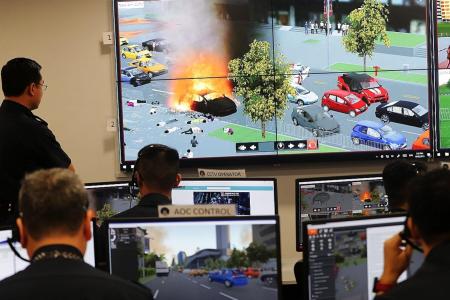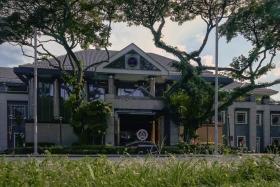Home Team Academy launches new simulation system
New simulation system allows commanders to react to various crisis scenarios at the same time
Imagine a vehicle bomb explosion, a chemical attack and a riot taking place at the same time in different parts of Singapore.
How will the different Home Team departments react?
Since January, the Home Team has been conducting exercises involving its various departments, including the Singapore Police Force and Singapore Civil Defence Force, using a new simulation system.
Looking like a virtual reality game but on a much larger scale, commanders in different rooms watch scenes unfold on large screens as they give instructions on their headsets.
For example, in a riot situation, as commanders give their orders, 3D images show officers on the ground confronting rioters on actual Singapore streets.
Developed by the Home Team Academy and customised based on technology by Dutch company XVR Simulation, the makers focused on realism in simulating emergency and crisis scenarios.
Four areas in Singapore - Bishan, Orchard Road, Marina Bay Sands and Little India - have been mapped out, right down to the individual buildings.
The system, in development since last year, was launched yesterday by Home Affairs and Law Minister K. Shanmugam at the new Home Team Simulation Centre in Choa Chu Kang.
Speaking at the launch, Mr Shanmugam said the system allows for joint operations training between departments.
He said: "We will need to strengthen Home Team integration, based on common values, a shared mission and the academy has a key role to play in that."
The system works like this: Commanders are housed in different rooms, each with a specific role - there is a front-line post; forward-command posts near the incident sites; and a main, more removed, command post located at headquarters. They are referred to collectively as the mock command centre.
In a separate simulation control room, officers in charge of the training introduce rapid scenario changes and live "injects", meaning disruptions such as the appearance of a violent protester. This is to generate unpredictability.
The commanders have to communicate effectively from their various posts, while under pressure, so that there is a cohesive chain of command for officers on the ground to act. The scenarios then evolve based on decisions made by the different commanders.
FOR MORE, READ THE STRAITS TIMES TODAY
Get The New Paper on your phone with the free TNP app. Download from the Apple App Store or Google Play Store now



